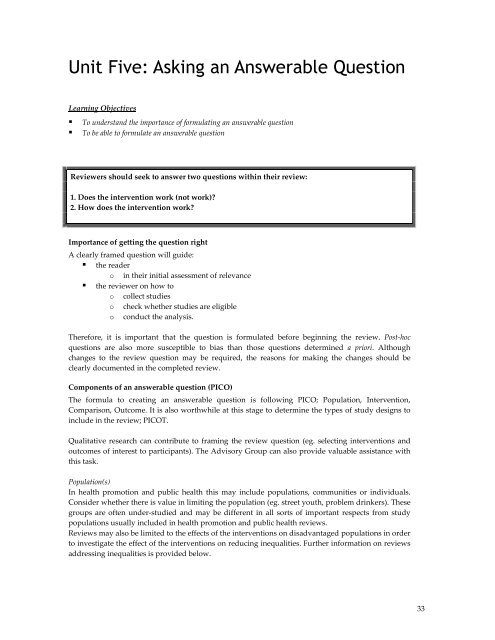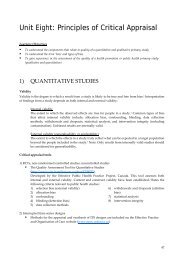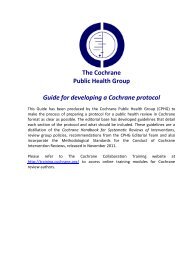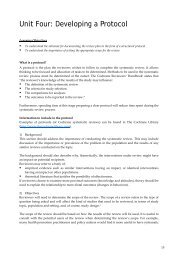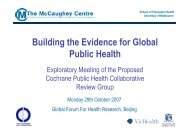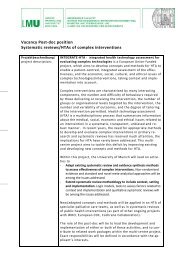Train the Trainer Course book - Cochrane Public Health Group
Train the Trainer Course book - Cochrane Public Health Group
Train the Trainer Course book - Cochrane Public Health Group
Create successful ePaper yourself
Turn your PDF publications into a flip-book with our unique Google optimized e-Paper software.
Unit Five: Asking an Answerable Question<br />
Learning Objectives<br />
To understand <strong>the</strong> importance of formulating an answerable question<br />
To be able to formulate an answerable question<br />
Reviewers should seek to answer two questions within <strong>the</strong>ir review:<br />
1. Does <strong>the</strong> intervention work (not work)?<br />
2. How does <strong>the</strong> intervention work?<br />
Importance of getting <strong>the</strong> question right<br />
A clearly framed question will guide:<br />
<strong>the</strong> reader<br />
o in <strong>the</strong>ir initial assessment of relevance<br />
<strong>the</strong> reviewer on how to<br />
o collect studies<br />
o check whe<strong>the</strong>r studies are eligible<br />
o conduct <strong>the</strong> analysis.<br />
Therefore, it is important that <strong>the</strong> question is formulated before beginning <strong>the</strong> review. Post-hoc<br />
questions are also more susceptible to bias than those questions determined a priori. Although<br />
changes to <strong>the</strong> review question may be required, <strong>the</strong> reasons for making <strong>the</strong> changes should be<br />
clearly documented in <strong>the</strong> completed review.<br />
Components of an answerable question (PICO)<br />
The formula to creating an answerable question is following PICO; Population, Intervention,<br />
Comparison, Outcome. It is also worthwhile at this stage to determine <strong>the</strong> types of study designs to<br />
include in <strong>the</strong> review; PICOT.<br />
Qualitative research can contribute to framing <strong>the</strong> review question (eg. selecting interventions and<br />
outcomes of interest to participants). The Advisory <strong>Group</strong> can also provide valuable assistance with<br />
this task.<br />
Population(s)<br />
In health promotion and public health this may include populations, communities or individuals.<br />
Consider whe<strong>the</strong>r <strong>the</strong>re is value in limiting <strong>the</strong> population (eg. street youth, problem drinkers). These<br />
groups are often under-studied and may be different in all sorts of important respects from study<br />
populations usually included in health promotion and public health reviews.<br />
Reviews may also be limited to <strong>the</strong> effects of <strong>the</strong> interventions on disadvantaged populations in order<br />
to investigate <strong>the</strong> effect of <strong>the</strong> interventions on reducing inequalities. Fur<strong>the</strong>r information on reviews<br />
addressing inequalities is provided below.<br />
33


